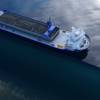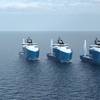Naming of UASC's 'Barzan' at HSHI, S. Korea
Barzan, the first in a series of six 18,800 TEU container vessels ordered by UASC, was recently named at Hyundai Samho Heavy Industries (HSHI) in Mokpo, South Korea. The vessel is the first to receive classification society DNV GL’s new GAS READY notation. Her five sister ships, as well as eleven 15,000 TEU vessels of UASC’s newest eco-ship generation, will be given the GAS READY notation as well.
“We are proud to help realise the world’s greenest ultra-large container vessel in close cooperation with UASC,” said Henrik O. Madsen, Group President and CEO of DNV GL. “Due to the trust placed in our expertise on alternative fuels, we implemented the ‘LNG ready’ concept with UASC as an industry first, and are honoured that these next-generation ships are now also the first to receive DNV GL’s Gas Ready Notation. UASC acted as a pioneering customer that aims to even further reduce CO₂ emissions through conversion to gas fuel operation when the bunker infrastructure is ready.”
Barzan, the largest vessel in UASC’s fleet to date, and all of the other 16 vessels in the current new building program, have been designed and constructed with the vision of undertaking a quick and cost efficient retrofit to LNG at a later stage. The DNV GL class notation GAS READY with nominators (D,S,MEc,AEi) demonstrates that the vessel is in compliance with the gas fuelled notation rules, that structural reinforcements to support fuel containment system (LNG tank) have been verified (S), that the main engines installed can be converted to dual fuel (MEc ) and that the auxiliary engines installed can be operated on gas (AEi).
“We are expanding our fleet by building larger, greener vessels, which support our global ambitions to fulfil or even exceed our customers’ environmental requirements. We have worked closely with DNV GL to deliver the industry’s greenest container vessel to date, the Barzan. We believe that this vessel, as well as the rest of the vessels in our new building program, demonstrates our commitment to technical innovation and eco-effectiveness,” said Jørn Hinge, President and Chief Executive Officer of UASC. “For UASC, achieving optimum efficiency levels is not a single initiative or project, it is a strategy and an ongoing commitment, and we will continue to work with DNV GL on the remaining newbuild vessels that have the lowest levels of CO2 output in their class”, he added.
“Gas will almost certainly continue to grow in importance as a fuel for shipping over the coming few years,” said Gerd Würsig, Business Director LNG fuelled ships at DNV GL – Maritime. “The framework and technical requirements have been laid and as the infrastructure spreads it will become a more mainstream option for efficient and low emission shipping. It is by working with forward looking owners and yards like UASC and HHI that we at DNV GL have been able to build our competence in this field and offer such unique solutions as the GAS READY notation.”
Next to the LNG readiness, Barzan and her sister vessels incorporate several innovative energy saving methods, including a Waste Heat Recovery System (WHRS). This converts thermal energy from the exhaust gas from the main engines into electrical power to maximize the efficiency of the system.
Preliminary calculations indicate that Barzan will have an EEDI (Energy Efficiency Design Index) value that is close to 50 per cent less than the 2025 limit set by IMO, with a CO2 output per TEU that is more than 60 per cent lower than a 13,500 TEU vessel delivered just three years ago. The 18,800 TEU containership has been constructed to DNV GL class rules with the notations: 1A1 Container Carrier DG-P Shore Power E0 NAUT-OC HMON (A1,C1,G4) CLEAN BWM-T BIS TMON NAUTICUS (Newbuilding) GAS READY (D, S, MEc, AEi).












